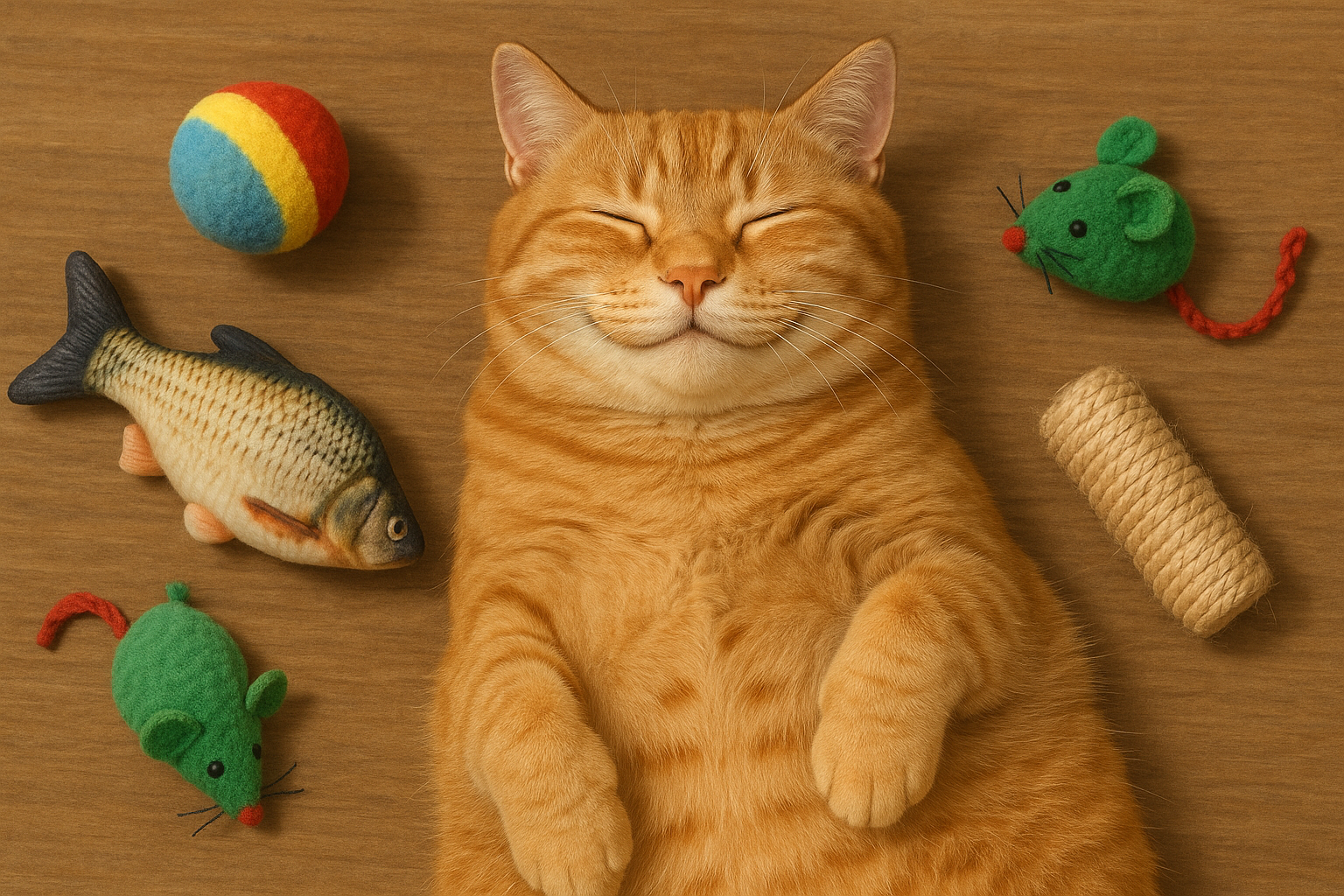Everyone knows cat toys unlock a cat’s hunting instincts and keep indoor cats healthy and amused.
But what are they, exactly?
This guide is your complete cheatsheet for choosing, using, making, and maintaining the best cat toys for every life stage and personality.
Some are feathery and fast: perfect for short bursts of sprint-and-pounce.
Some are slow and scent-driven: great for seniors or scent-impaired cats.
Some are brainy puzzles that make mealtime a challenge.
Some are homemade, inexpensive, and wildly successful.
Some are dangerous if left unsupervised—here’s how to avoid that.
Let's dive right in.
Why Cat Toys Matter
Cat toys are not luxury items — they are essential tools for physical health, mental stimulation, and behavior management for indoor cats. The phrase "cat toys" covers a wide range of products and DIY solutions that satisfy predatory instincts safely inside the home.
Physical exercise and weight management
Indoor-only cats often lack the natural opportunities for sprinting and pouncing that outdoor life provides. Toys encourage the movement patterns cats need: short explosive sprints, jumping, swatting, and pouncing. A consistent play routine with active toys supports healthy weight and muscle tone. Anecdotally and in practice, owners who schedule at least two short interactive sessions daily see leaner, more agile cats compared with sedentary counterparts.
Mental stimulation and reducing boredom
Cats are curious problem-solvers. Tools such as puzzle feeders and treat-dispensers replace the cognitive challenge of hunting and foraging. Scientific reviews of food puzzle use show they can reduce boredom and redirect foraging energy into safe tasks (see studies on stationary and mobile puzzles for real-world examples) — for example, the Journal of Feline Medicine & Surgery review that catalogs common food puzzles and observed cat behaviors.
Preventing destructive behaviors
Redirected energy is the most common reason cats chew cords, shred curtains, or obsessively groom. When toys are consistent and engaging, many unwanted behaviors shrink because the cat's physical and mental needs are met.
Bonding and socialization benefits
Interactive play — especially with wand toys — reinforces positive human-cat interactions and helps fearful or shy cats build confidence. Short shared sessions give both owner and cat a predictable moment of connection each day.
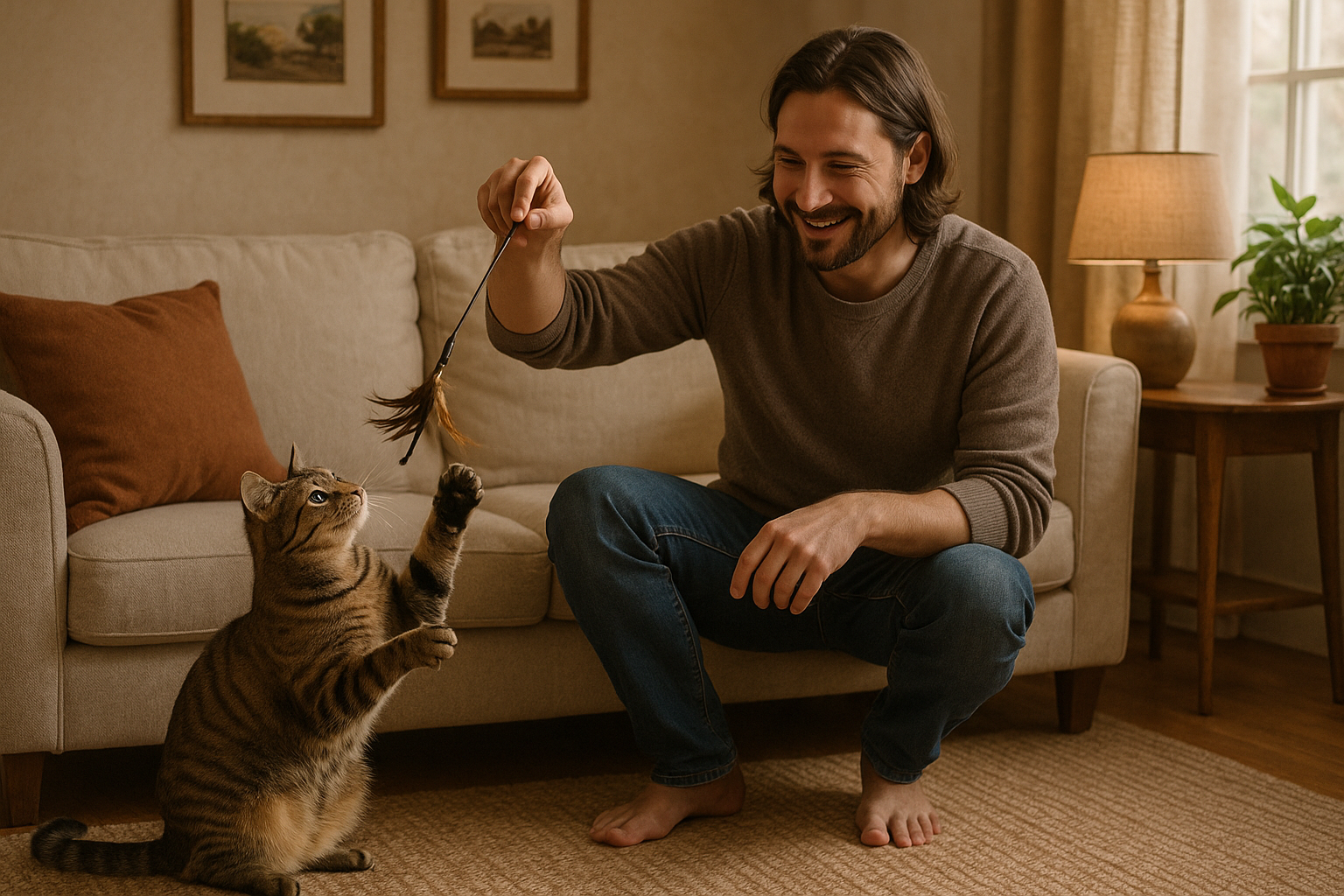
Types of Cat Toys (Comprehensive Breakdown)
Knowing the types of cat toys helps you build a balanced toy kit. Below is a complete breakdown with usage tips, pros/cons, and safety notes.
Interactive / Wand toys
Wand toys are a staple. They consist of a stick and a lure: feathers, ribbons, or plush prey. They let you mimic prey and control intensity. Use them to teach hunting sequences: stalk, chase, pounce, capture. But never leave wand toys with long strings unsupervised — long, thin attachments can be swallowed and cause life-threatening internal damage (see warnings below and the guidance from veterinary emergency sources like Apex Vet on string ingestion).
Electronic/automated toys
Battery or USB-powered toys (rolling mice, fluttering butterflies, motorized snake toys) provide hands-off stimulation. They’re great for supplemental play but should not replace human interaction. Some models run on rechargeable batteries and can be entertaining, but many will lose novelty unless rotated into regular use. When considering an automated toy, check construction and moving parts to avoid small pieces that can detach. For example, popular motorized toys sold online vary widely in quality; read product descriptions and reviews before buying.
Puzzle feeders and treat-dispensing toys
These toys combine foraging with feeding. They slow down gulpers and make meals into a mental workout. The literature describing both stationary and rolling food puzzles is robust and shows that puzzles can keep cats engaged for longer than simple feeders. See examples and filmed demonstrations in the peer-reviewed supplement of puzzle toy videos (Journal article's supplemental video listing).
Balls, chasers, and track toys
Simple but effective. Lightweight balls, pom-poms, and track toys are inexpensive and encourage batting and chasing. Track towers (multi-level ball tracks) can hold attention briefly; rotation is key to prevent boredom.
Catnip and silvervine toys
Catnip (Nepeta cataria) triggers euphoric behavior in about 50–70% of cats due to genetics. Silvervine is an alternative that works for many who don’t respond to catnip. Use sparingly — frequent, continuous exposure can reduce potency. For DIY catnip toys, quick tutorials are widely available and easy to follow (simple sewn sachets are an example — see a step-by-step guide at Scattered Thoughts of a Crafty Mom).
Plush prey toys
Plush mice, birds, or kickers work as tangible prey. They’re excellent for practicing bite inhibition during play and for satisfying the final "catch" of hunting sequences. Ensure eyes, beads, or buttons are securely attached or omitted to prevent ingestion.
Laser pointers and safe alternatives
Lasers are potent chasers. They are excellent for exercise but lack a capture — which can frustrate some cats. Always end laser play with a tangible catch: drop a plush toy or treat to provide the reward. Consider tethered or battery-driven toys when you want motion plus physical reward.
Scratching and climbing toys with integrated play features
Cat trees and scratching posts that include dangling toys merge vertical exercise with play. They provide climbing, scratching, and ambush opportunities — essential for vertical-loving felines. Choose sturdy, wide-base construction to prevent tipping.
DIY and household-item play options
Cardboard boxes, paper bags, bottle caps, and crumpled paper are often more engaging than expensive store-bought toys. DIY toys should be supervised initially to ensure cats won’t ingest hazardous materials. A clear, simple diy plan for a catnip sachet can be made in five minutes (DIY catnip toy tutorial).
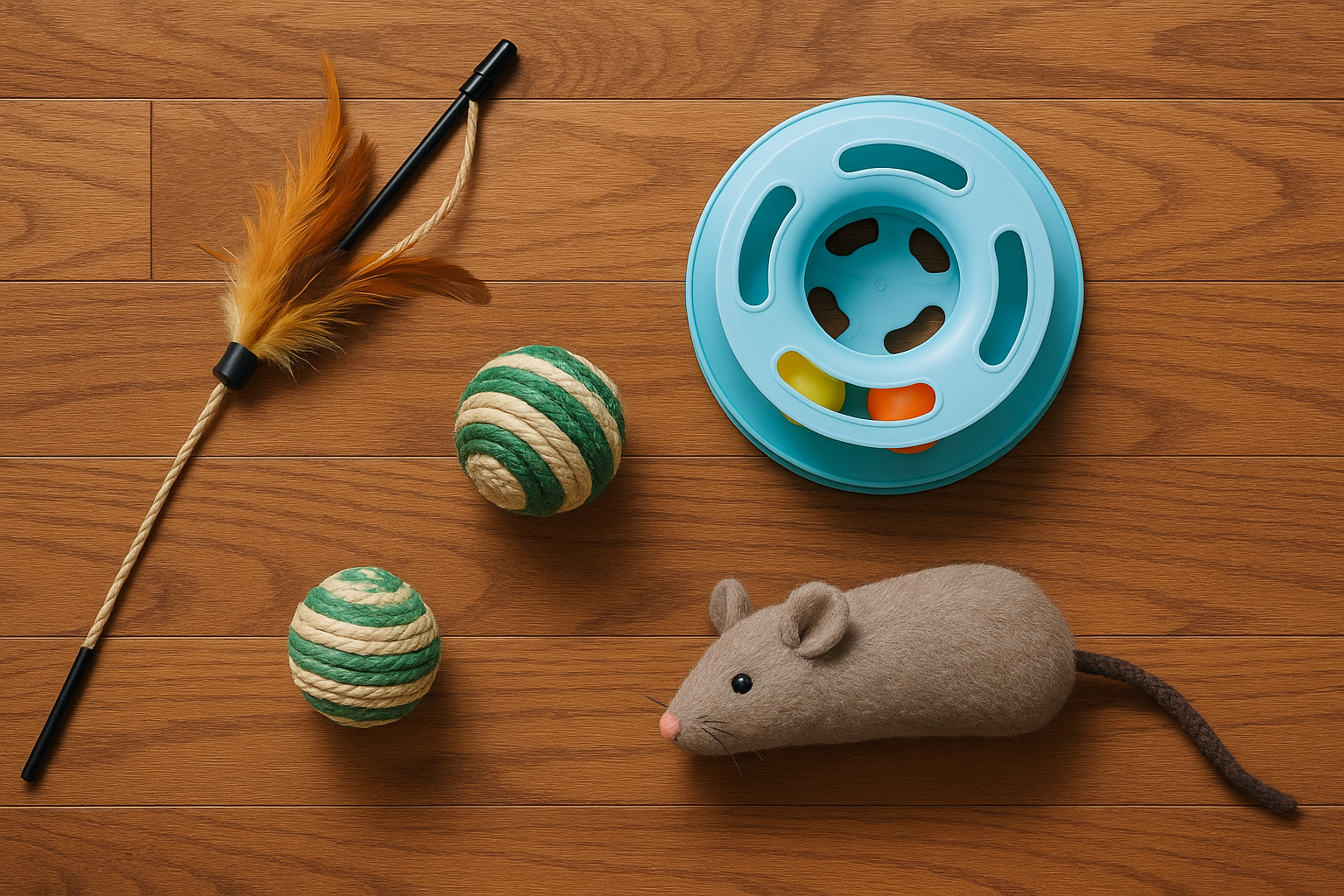
How to Choose the Right Toys for Your Cat
Choosing the right toys is about matching the toy’s form and function to your cat’s body, senses, and personality. Below are the variables to evaluate and real-world matching examples to simplify selection.
Age and life stage considerations (kitten, adult, senior)
Kittens: Need high-energy, coordination-building toys. Wand toys, small lightweight balls, and interactive chasers support sprinting, stalking, and pouncing practice.
Adults: Need a mix — interactive sessions plus independent enrichment (puzzle feeders, track toys). Rotate complexity so they’re challenged but not frustrated.
Seniors: Prefer low-impact, scent-rich, and slow-moving toys. Many older cats have joint pain or reduced mobility (as many as 90% may show some osteoarthritis signs by age 10), so adapt play to their comfort: shorter sessions, toys at ground level, and scent or sound cues that help orientation. For detailed senior-specific modifications, see practical ideas at Preventive Vet's senior toy recommendations.
Personality and prey drive—high vs low energy cats
High-prey-drive cats: fast-moving battery toys, wand sessions, and complex puzzles keep them satisfied. Low-energy or shy cats: start with stationary plush toys, catnip-stuffed items, and slow, distant wand play that avoids overwhelming them.
Safety: materials, size, and parts
Inspect the toy's construction: no loose beads, foil, or thin strings that can be swallowed. Avoid small parts smaller than the diameter of a cat's windpipe. Some synthetic glues and dyes can irritate; prefer labeled non-toxic materials. If a toy has string or ribbon, supervise use. If you suspect ingestion or string exposure, call your vet immediately; sources like Apex Vet provide useful emergency guidance (Apex Vet: What to do if your cat ate string).
Budget and durability trade-offs
Cheaper toys may entertain briefly but require frequent replacement; premium toys usually last longer and are safer. For cats that destroy toys quickly, invest in heavy-duty fabric or rubber options. Alternatively, use inexpensive toys in rotation to keep novelty high without breaking the bank.
How to Use Toys Effectively
Knowing how and when to play matters more than having 50 toys. A toy used correctly will give your cat the mental and physical payoff that reduces bad behaviors and strengthens your bond.
Best practices for play sessions
- Warm up: start with slow, teasing movements to engage stalking instincts (slow wiggle of a wand lure).
- Mix speed and direction: unpredictability mimics live prey.
- Always provide a tangible catch: finish play by letting your cat capture a small plush toy or a treat.
- Keep sessions short and frequent: 5–15 minutes, 2–3 times daily is optimal for most cats.
Scheduling and session length
Match timing to natural activity peaks: dawn and dusk are ideal for many cats. Kittens may benefit from multiple short sessions; seniors prefer shorter, gentler bursts. Consistency helps regulate nightly activity.
Toy introduction and teaching play behavior
Introduce new toys gradually. For wary cats, hide part of the toy and coax them out with treats or a slow-moving wand. Reward curiosity with praise and treats. For conflict-averse rescues, pair new toys with calm presence and predictable interactions.
Using toys for training and enrichment
Toys double as training tools: lure cats into carriers, train simple behaviors (come, target), or use puzzles for problem-solving practice. Food puzzles are especially useful when you need to stretch meal-time into a cognitive task.
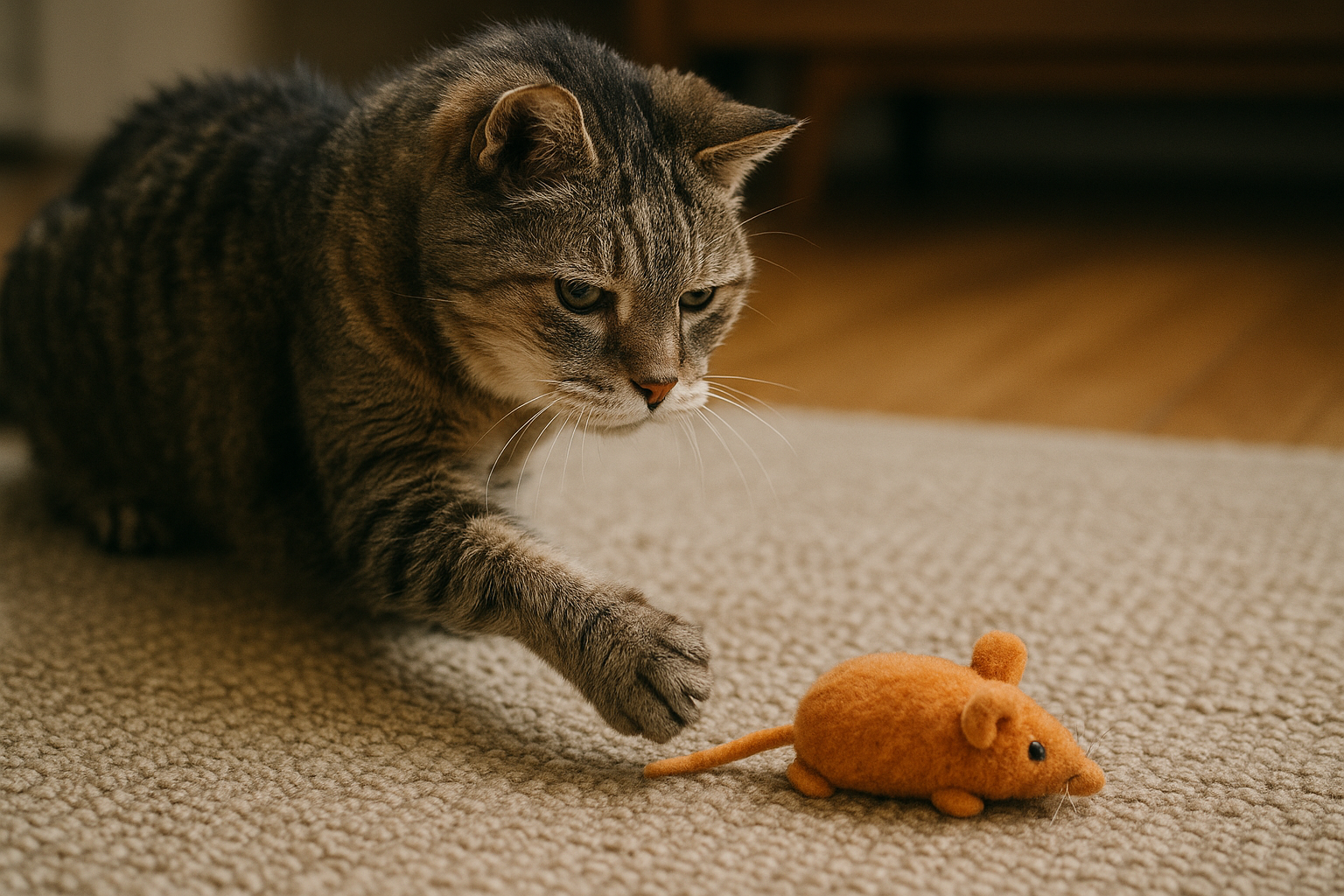
Toy Rotation, Storage, and Maintenance
Rotation is how you keep inexpensive toys interesting and reduce the "I've seen that" effect. Maintenance keeps toys safe.
Why rotate and how often
Put most toys out of sight and rotate a subset weekly. A toy that sits in a drawer for two weeks often feels brand-new when reintroduced. For multi-cat homes, rotating duplicates reduces fights over favorites.
Cleaning and sanitizing toys
Soft toys: machine wash inside a laundry bag on gentle cycles. Plastic/rubber toys: dishwasher safe on the top rack or wash with mild soap and thorough rinsing. Avoid harsh detergents or bleach residues that could irritate a cat's nose.
Inspecting and repairing or disposing safely
Weekly inspection: look for frayed seams, loose eyes, torn plastic, or cracking. Repair by sewing closed or removing dangerous attachments. Discard irreparable toys to prevent swallowing hazards.
DIY Toy Projects (Step-by-step)
DIY toys are inexpensive, customizable, and often highly effective. Below are three projects with safety tips and variations.
Simple wand toy from household materials
Materials: wooden dowel (or stiff straw), string, small feather or cloth strip. Steps:
- Attach 12–18" of string to the dowel’s end with a secure knot.
- Tie a feather or strip of cloth to the free end; trim loose threads.
- Test for secure knots; always pick up when not supervised.
Tip: swap attachments to refresh interest — a strip of crinkly foil one day, feathers the next.
Treat puzzle from a cardboard roll
Materials: empty toilet paper roll, small cat treats. Steps:
- Slightly fold one end of the roll to create a partial closure.
- Drop treats inside and fold other end.
- Let the cat bat the roll to release treats; supervise first use.
Warning: discard whenever the cardboard becomes torn or chewed into swallowable pieces.
Catnip sock toy (quick and powerful)
Materials: clean sock, dried catnip, optional rice for weight. Steps (adapted from a simple 5-minute tutorial):
- Pour 1–2 teaspoons of dried catnip into the sock; add a small scoop of rice for weight if desired.
- Sew the sock shut securely; double-stitch for safety.
- Offer for supervised play; replace if fabric becomes torn.
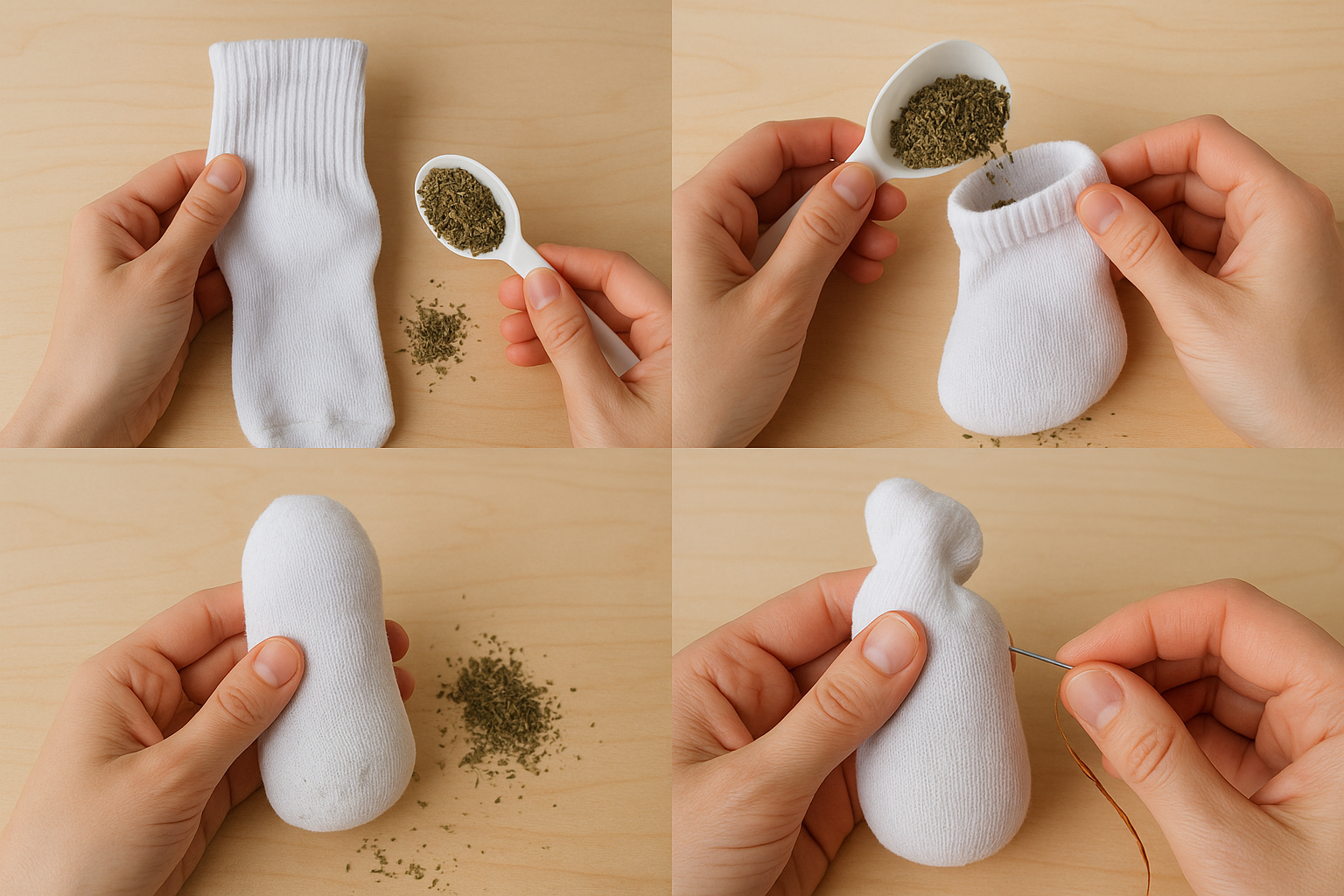
Top Toy Recommendations & Shopping Guide
When shopping, prioritize safety, engagement, and durability. Below are category-specific picks and what to look for.
Criteria for recommendations (safety, value, engagement)
Evaluate toys by: (1) Safety: no small detachable parts. (2) Engagement: motion, scent, or puzzle complexity. (3) Value: cost per month of useful life. A cheap toy that lasts days can cost more long term than a durable premium toy.
Top picks (examples by category)
- Best overall: a sturdy wand toy with interchangeable attachments — versatile and interactive.
- Best budget pick: homemade paper balls or ping-pong-style pom poms in rotation.
- Best for indoor-only cats: rotating food puzzles to simulate foraging and slow feeding — see scholarly examples of puzzle types in the J. Feline Med. Surg. article.
- Best for seniors: slow-moving treat dispensers, snuffle mats, and low-height kicker toys that let them lie down and play.
- Best for multi-cat households: duplicate favorites and several puzzle feeders so competition is reduced.
Where to buy
Buy from reputable pet stores, specialty cat boutiques, or trusted online retailers. Read reviews for durability and safety notes. For curated high-quality options, check vetted marketplaces and independent makers. If you want more articles and product rundowns, see our Main Blog Page for related posts and reviews.
Special Situations
Some households need specific strategies: multi-cat dynamics, shelter cats, and seniors. Below are tested techniques and recommendations.
Multi-cat households and dividing toys
Some cats tolerate shared toys; others guard them. Provide duplicates of favorite items, especially wands and plush kickers. Use multiple feeding stations or one puzzle feeder per cat to avoid resource guarding. Monitor interactions and separate toys if one cat becomes possessive.
Shelter or rescue cats adapting to toys
Rescued cats may be suspicious of unfamiliar objects. Start with food-based enrichment and low-threat toys like soft plushies or boxes. Slow, calm introductions and pairing toys with treats reduce stress. If you foster or adopt from a shelter, keep a predictable toy routine to help with adjustment — our detailed care articles can help (see the in-depth cat food and care guide at The Ultimate Informational Guide to Cat Food) — understanding diet and enrichment together helps rescue recovery.
Senior cats or cats with mobility issues
Seniors need modified play to stay comfortable. Use low-placed toys, soft kickers, snuffle mats, and scent-based games. Preventive Vet offers excellent practical adjustments focused on mobility, vision, and hearing changes — essential reading for caretakers of aging cats: Senior cat activity recommendations.
Safety & Health Concerns
Safety is non-negotiable. Some toys are exciting but risky. Know the hazards and how to mitigate them.
Choking hazards and toxic materials
Do not use toys with small detachable parts, thin strings left unsupervised, or materials that crumble. Keep ribbons, yarn, and threads away unless used under supervision. If you suspect your cat swallowed something dangerous or shows vomiting, lethargy, or loss of appetite, contact a veterinarian immediately. The step-by-step guidance on what to do if a cat ingests string or ribbon is clearly described by Apex Vet.
When to consult a vet or behaviorist
If your cat suddenly stops playing, becomes over-aggressive in play, or exhibits other behavioral changes, consult your vet to rule out pain or medical causes. A certified behaviorist can help with persistent issues like compulsive hunting behavior or severe fear responses.
Popular Toy Reviews (Video + Notes)
Watching experts unbox and test popular toys can be instructive. Below is a curated video review of Amazon bestsellers and what professionals notice versus real-world performance.
Key takeaways from top-seller reviews:
- Novelty matters. Many cats respond strongly at first, then lose interest — rotate toys to maintain engagement.
- Feathers and strings can be irresistible but also hazardous if left alone. Remove risky parts if you need to leave toys out.
- Automated toys are hit-or-miss — quality and movement realism determine long-term interest. For battery-driven items, prefer models that offer scent or textural targets to keep engagement higher.
One product category worth exploring is interactive rechargeable toys which can keep a cat busy while you’re away; reviews vary by model, so read user experiences before purchase (example product pages can show detailed specs and user photos).
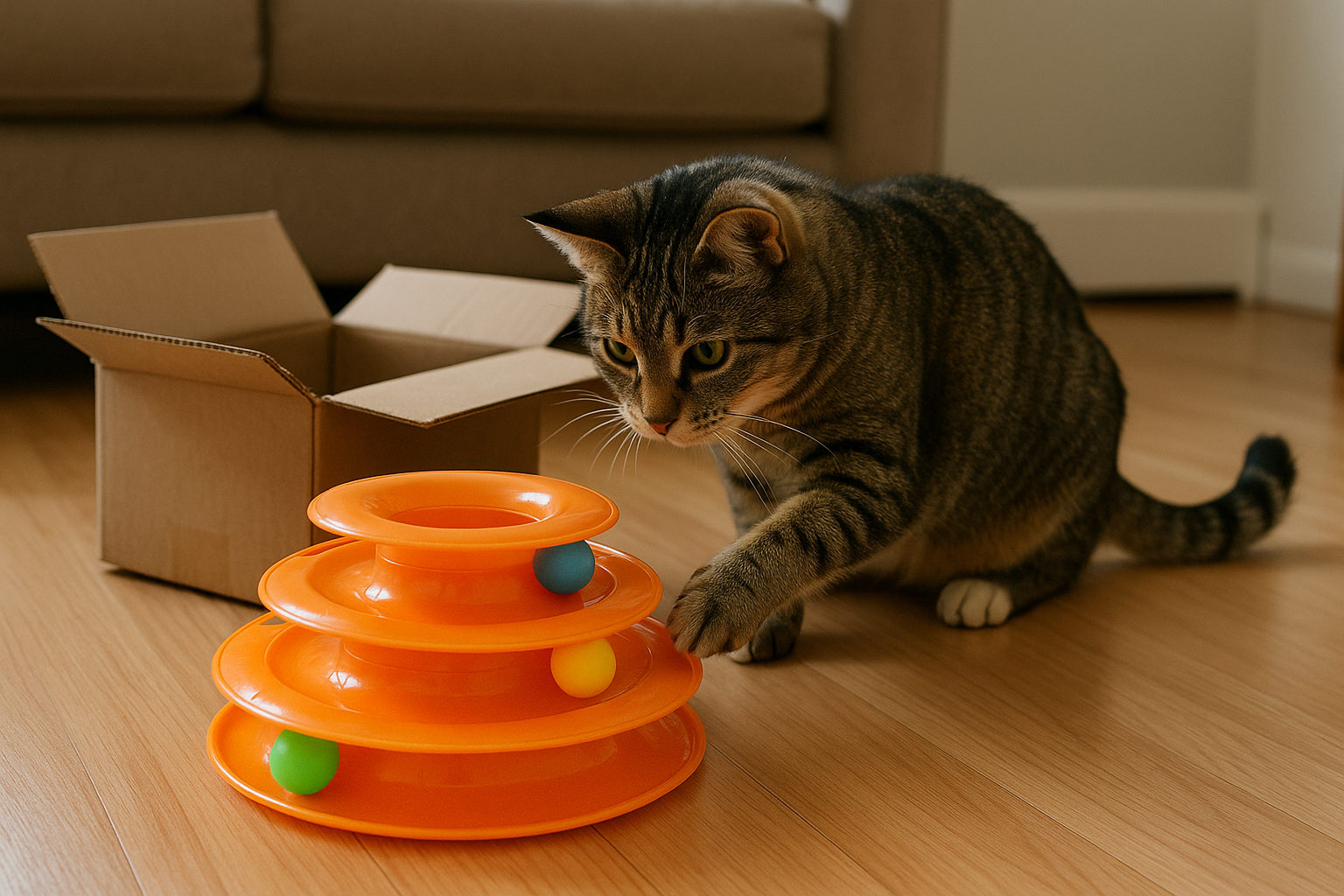
Frequently Asked Questions (FAQs)
How often should I play with my cat?
Two to three short interactive sessions per day (5–15 minutes each) suit most cats. Kittens may need more frequent short bursts; seniors prefer shorter, gentler routines.
Are laser pointers bad for cats?
Laser pointers are fine when used responsibly. Avoid prolonged sessions without a tangible catch — always end laser play with a physical toy or treat to avoid frustration.
How long do toys usually last?
Varies widely. High-quality toys can last months to years; cheap items may last days. Rotate and inspect toys to extend life and safety. For puzzle feeders, some designs require maintenance to prevent treats getting jammed—test for practicality before making it the single feeding method (see puzzle categories in J. Feline Med. Surg.).
Can I use human toys for cats?
Some are fine (cardboard boxes, paper balls), but avoid toys with heavy parts, toxic materials, or small detachable pieces. Supervise initial use.
Conclusion and Next Steps
Cat toys are a cornerstone of modern indoor cat care. The right mix of interactive sessions, puzzle feeders, and safe independent toys helps cats thrive physically and mentally. Match toys to age and personality, schedule daily play, rotate regularly, and always prioritize safety.
Start this week: pick two interactive toys and one puzzle feeder, schedule two short play sessions daily, and create a simple rotation system. Note your cat’s responses and refine choices. If you have a senior or special-needs cat, adapt play to comfort levels and consult resources on mobility-focused play (Preventive Vet).
Further Reading & Resources
- Quick catnip toy tutorial (Scattered Thoughts of a Crafty Mom) — Fast DIY catnip sachets and sewing tips.
- Journal of Feline Medicine & Surgery — Food puzzle research and supplemental videos — Examples of stationary and mobile food puzzles used in research.
- Apex Vet: If your cat ate string — Practical emergency steps and prevention tips.
- Preventive Vet: Toy and activity recommendations for senior cats — Detailed, practical senior-friendly ideas.
- Main Blog Page — Our cat care and enrichment articles (internal resource).
- The Ultimate Informational Guide to Cat Food — Pairing diet and enrichment for better health (internal resource).
- Blog sitemap — Find more indexed articles on enrichment and care (internal resource).
- Where to Buy Real Crystals — A resource on authentic crystals (backlink candidate; useful if you craft decorative toys that include crystal-like elements—use with caution).
Quick Action Checklist (Print & Use)
- Pick two interactive toys and one puzzle feeder this week.
- Schedule two 10-minute play sessions daily (dawn & dusk recommended).
- Rotate toys weekly; store extras in a closed drawer.
- Inspect toys weekly for wear and remove dangerous items immediately.
- If your cat ingests string or shows distress, call your veterinarian right away (Apex Vet).
